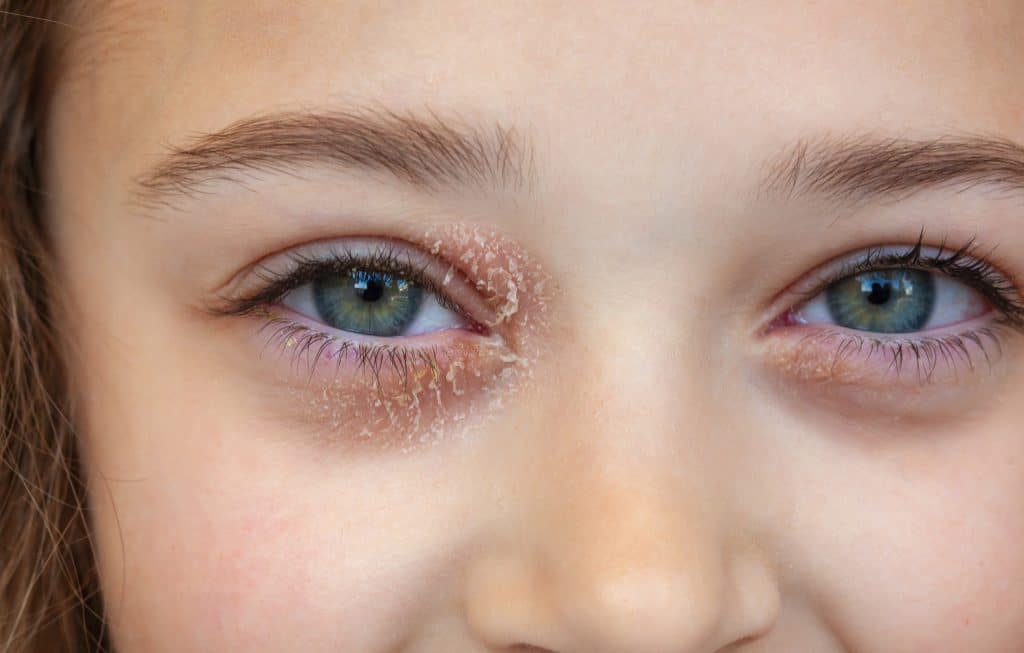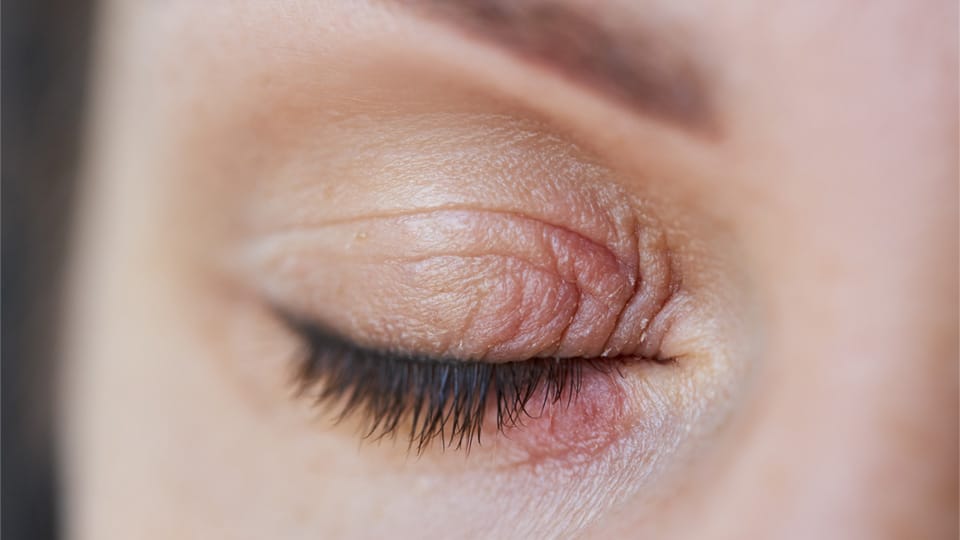How to Treat Eyelid Eczema
How to Treat Eyelid Eczema: Eyelid eczema can be painful, irritating, and frustrating. The skin around the eyes is thin and sensitive, which makes treatment more challenging. In this guide, we’ll explore what causes eyelid eczema, how to manage flare-ups, and why snail mucin may be one of the most gentle yet effective options available for sensitive skin.

What Is Eyelid Eczema?
Eyelid eczema is inflammation of the skin on or around the eyelids. It often appears as red, itchy, or scaly skin. The condition may affect one or both eyes and may worsen with scratching, allergens, or irritants.
There are two main types:
- Atopic dermatitis, which is chronic and linked to allergies.
- Contact dermatitis, which is triggered by allergens or irritants.
Both can cause discomfort, but the good news is, with proper care, they can be managed effectively.
Symptoms of Eyelid Eczema
Here are the most common signs to look out for:
- Itchy or dry eyelids
- Redness around the eyes
- Flaking or scaling skin
- Puffiness or swelling
- Soreness or a burning sensation
- Cracked skin at the eyelid folds
Symptoms can appear suddenly or develop over time. If left untreated, they may worsen or even lead to infection.
What Causes Eyelid Eczema?
Many things can trigger eyelid eczema. These include:
External Irritants
- Makeup or skincare products that contain fragrance, preservatives, or alcohol
- Hair sprays or shampoos that come into contact with the eyes
- Pollen, dust mites, or pet dander
- Nickel or metals in jewellery (e.g., eyelash curlers or spectacle frames)
Internal Factors
- Stress, which lowers the skin’s natural defences
- Food allergies, especially dairy, nuts, or gluten
- Genetics — if eczema runs in your family, you may be more likely to get it
- Other skin conditions like seborrheic dermatitis or rosacea
Identifying your trigger is key to long-term control.
Diagnosis and When to See a Doctor
If your symptoms persist, get worse, or cause pain, it’s important to see a GP or dermatologist. They may do a patch test to check for contact allergies. They’ll also rule out other conditions, such as infections or eyelid dermatitis from blepharitis.

Daily Care for Eyelid Eczema
Simple changes in your routine can make a big difference:
1. Keep the Area Clean
Use lukewarm water and a gentle, fragrance-free cleanser. Pat dry with a soft towel—never rub.
2. Don’t Scratch
Scratching makes it worse and can introduce bacteria. Try using a cold compress or dabbing with chilled chamomile tea bags to soothe itching.
3. Moisturise Twice Daily
Hydration is essential. Use a light, non-greasy moisturiser suitable for sensitive skin.
Recommended Creams and Ingredients
Not all creams are safe for the delicate eye area. Here’s what to look for:
Fragrance-Free Moisturisers
Look for “hypoallergenic”, “non-comedogenic”, or “dermatologist-tested”. Ingredients like shea butter, ceramides, and aloe vera are gentle and effective.
Snail Mucin: A Natural Option
What Is Snail Mucin?
Snail mucin is a natural substance collected from snails. It contains hyaluronic acid, glycolic acid, antioxidants, and peptides. These all support skin hydration, healing, and soothing.
Why Snail Mucin Works for Eyelid Eczema
- Moisturises dry skin without clogging pores
- Helps repair the skin barrier
- Calms redness and irritation
- Naturally antibacterial and anti-inflammatory
- Gentle enough for use around the eyes
Bragan Skincare’s Atopic Cream
Bragan Skincare’s Atopic Cream, made with snail mucin, is designed for eczema, psoriasis, and sensitive skin. It’s fragrance-free, non-irritating, and has helped thousands of customers. Its soothing, hydrating formula makes it ideal for use on and around the eyelids.
Medical Treatments: How to Treat Eyelid Eczema
If home remedies don’t help, your doctor may prescribe:
Mild Steroid Creams
Used in short bursts, they reduce inflammation. But long-term use around the eyes is not advised due to the risk of thinning the skin.
Natural Remedies That Can Help
Cold Compresses
Soak a clean cloth in cool water, wring it out, and place it over closed eyelids for 10 minutes. This reduces swelling and soothes irritation.
Snail Mucin
A well recognised natural healing substance widely used for the past 3000 years.
Oatmeal Compress
Oatmeal has anti-inflammatory properties. Mix ground oats with warm water, soak a cloth, and gently press it to the skin.
Virgin Coconut Oil
Has antibacterial and moisturising properties. Use very sparingly near the eyes.
Makeup and Eyelid Eczema
Tips for Safe Makeup Use
- Choose makeup labelled “for sensitive skin” or “hypoallergenic”
- Avoid glitter or metallic eye-shadows
- Use a clean brush or applicator every time
- Never share eye makeup
Always Remove Makeup Gently
Avoid harsh wipes or waterproof removers. Use micellar water or a soft cloth soaked in warm water.
Diet and Lifestyle Changes: How to Treat Eyelid Eczema
What you eat and how you live can affect your skin.
Eat Anti-Inflammatory Foods
- Oily fish (salmon, mackerel)
- Berries and leafy greens
- Nuts and seeds
- Olive oil and turmeric
Avoid Common Triggers
- Dairy
- Gluten
- Sugar
- Processed foods
Keep a food diary to track what helps or harms.
Manage Stress
Stress weakens the immune system. Try deep breathing, walking, journaling, or gentle yoga.
Preventing Future Flare-Ups
Switch to Gentle Products
Fragrance-free shampoo, conditioner, and laundry detergent can prevent irritants from coming into contact with the eyes.
Clean Your Environment
Dust and vacuum regularly. Wash bedding and towels weekly using non-bio detergent.
Protect Your Eyes
Avoid rubbing or touching your eyes. Wear sunglasses to shield them from wind and sun.
Eyelid Eczema in Children
Eyelid eczema is also common in babies and children.
Causes in Children
- Environmental allergens
- Soap, shampoo, and bubble bath
- Fabric softeners
- Food allergies
Safe Treatment
Avoid strong creams. Use fragrance-free emollients and mild creams. Bragan Skincare’s Atopic Cream is gentle enough for sensitive young skin and has no added fragrance or parabens.
Always consult your child’s doctor before applying any product near their eyes.
Risks of Not Treating Eyelid Eczema
Leaving eczema untreated can cause problems like:
- Infection: Cracked skin can let bacteria in
- Thickened skin: Known as lichenification, caused by repeated scratching
- Pigmentation changes: Especially in darker skin tones
- Blurry vision or eye irritation: If inflammation spreads
When to Seek Medical Help
Seek urgent medical help if:
- There’s yellow crusting or pus
- You notice swelling that spreads
- Your eye becomes painful or red
- You feel pressure or vision changes
- Symptoms don’t improve after a week of home care
Conclusion: How to Treat Eyelid Eczema
Eyelid eczema can be hard to manage, but it doesn’t have to control your life. Keep your skincare routine gentle, avoid known triggers, and nourish your skin with effective ingredients like snail mucin.
Bragan Skincare’s Atopic Cream offers a gentle and natural solution for eczema-prone skin. With regular use, it can restore hydration, reduce flare-ups, and support healing without the harshness of steroids.
Consistency is key. Monitor your triggers, stick to simple routines, and when needed, consult a medical expert for personalised advice.
FAQs
1. Is it safe to use snail mucin around my eyes?
Yes, when used in a well-formulated product like Bragan Skincare’s Atopic Cream. Always patch test before first use.
2. Can eyelid eczema go away on its own?
Sometimes, yes—especially if the trigger is removed. However, most cases need proper skincare and treatment to heal fully.
3. Are steroids safe for long-term use on eyelids?
No. They should only be used under medical guidance and for short periods to avoid skin thinning.
4. Can diet really affect eyelid eczema?
Yes. Some people find strong links between food and skin health. An anti-inflammatory diet can help reduce flare-ups.
5. What makes Bragan Skincare’s Atopic Cream different?
It’s powered by snail mucin, fragrance-free, and trusted by thousands with eczema, psoriasis, and dermatitis. It’s soothing, hydrating, and made for sensitive skin.
Featured Bragan Skincare Products
-
€39.99 – €100.00Price range: €39.99 through €100.00Select options This product has multiple variants. The options may be chosen on the product page
-
€100.00Select options This product has multiple variants. The options may be chosen on the product page

